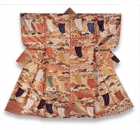Japanese Gallery (Honkan) Room 9
August 29, 2006 (Tue) - October 29, 2006 (Sun)
Some people may be familiar with karaori, the vibrant-colored garments that are worn to denote female roles in Noh plays. However, the term originally refers to a type of fabric. Developed towards the end of the Muromachi period (1392-1573), "karaori" are characterized by the woven patterns that could be mistaken for embroidery in a rich variety of designs. Although karaori means "Chinese style textile", Chinese textiles with these features have not been found to exist.
The designs of karaori have changed over time. The use of gaudy gold threads began with the development of a flourishing culture during the Genroku era (1688-1704). While the colors and designs of karaori costumes gave Noh stages a profound and mysterious effect, they also reflect the characteristics of the roles being portrayed. For roles of high-ranking beautiful women, such as the consort of the Tang emperor Xuanzong, Yang Guifei, the designs were auspicious peonies and phoenix rendered in shining gold and brightly colored threads; for roles like an elderly mother, quietly elegant designs such as autumn plants with a small amount of red color were used. Nurtured in the world of Noh theater and an outstanding traditional textile of Japan, the development of karaori was only possible due to the advanced weaving techniques of the Edo period.

